
(C) Jo Ellen Meyers Sharp
Winter has finally arrived in Central Indiana. As I write this, the ground is covered with about an inch of snow and the sun is playing hide-and-seek.
In a few days, though, the temps will move up to the 40s, again challenging plants that have been fooled out of the ground because of our long fall and winter of warm weather. Some plants though are tough and up to the challenge of Indiana’s always changing climate.
Here’s a sampler:
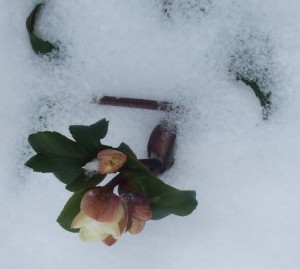
(C) Jo Ellen Meyers Sharp
Helleborus Cinnamon Snow has started blooming. I transplanted this from the back to the front yard, where it will get a tad bit more sun and where I can see it a little better. Cinnamon Snow (H. x ballardiae) is from the Skagit Gardens’ Gold Collection. It is the earliest blooming hellebore I have.
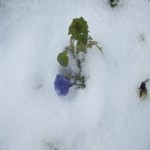
(C) Jo Ellen Meyers Sharp
Thanks to Ball Horticulture for sending me some Cool Wave pansies to try. They have been blooming all fall and are still blooming, even under the snow. The flowers are yellow, white and blue.
The ornamental cabbage is holding its own, dressed up a bit still with some boughs of winter greenery. I saw some ornamental cabbage used in holiday containers this year, which is definitely something I’m going to try with a client next year. Using the cabbage will get two glorious seasons from a traditional fall ornamental.
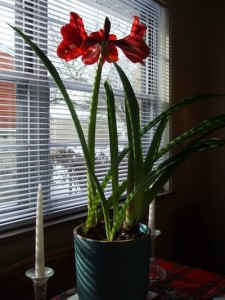
(C) Jo Ellen Meyers Sharp
Indoors, the amaryllis demands all the attention. I have had this red one for many years and have had reasonably good luck at getting these tender bulbs to bloom every year.
In summer, I pot up several single bulbs into a bigger container and move them outdoors in a sunny location. I fertilize when I do my other pots. In fall, I move the amaryllis indoors, cut back the leaves and put in a sunny window. Voila! Blooms early in the year.
Lastly, I’m grateful for two secrets Mother Nature revealed to me this past December. It helps when the lost secrets have bright red handles.
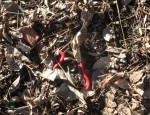
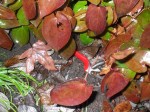
That’s a great showing of blooms for January. My amaryllis hasn’t bloomed yet, but it should soon, I hope. Thanks for joining in for bloom day.
Good post. My Hellebores from that Gold Collection have been great. And super congrats on the pruners. That is more amazing than flowers outdoors in January!
Thank you, Irvin. Indeed, finding those pruners has been the best part of winter’s secrets — so far!
Thanks, Leslie — indeed, red-handled tools make them easier to find.
Hellebores in the snow make for such a happy and sad photo! I see I’m not the only one who loses things in the garden! It should be a requirement that all garden tools have red handles! Happy GBBD!
Hi, Holleygarden — thanks for your post. Fortunately, the blooming hellebores are programmed for the job! Happy Garden Bloggers’ Bloom Day to you, too.
A great way to procrastinate, Kathy.
Barbara — thanks for visiting. Yes, you should try Cinnamon Snow. Skagit Gardens sent it as a sample a year or two ago. I love my amaryllis, too, one from the Netherlands Flower Bulb Information Center. And really, I don’t do anything to the amaryllis other than what I said in the article. For most of us gardeners, hope springs eternal, so try amaryllis again.
Great fun seeing things others grow that I don’t. Amaryllis is one of them – Hellebores are another. Beauties!
Country Mouse — Amaryllis is definitely fix for plant hungry bloggers.